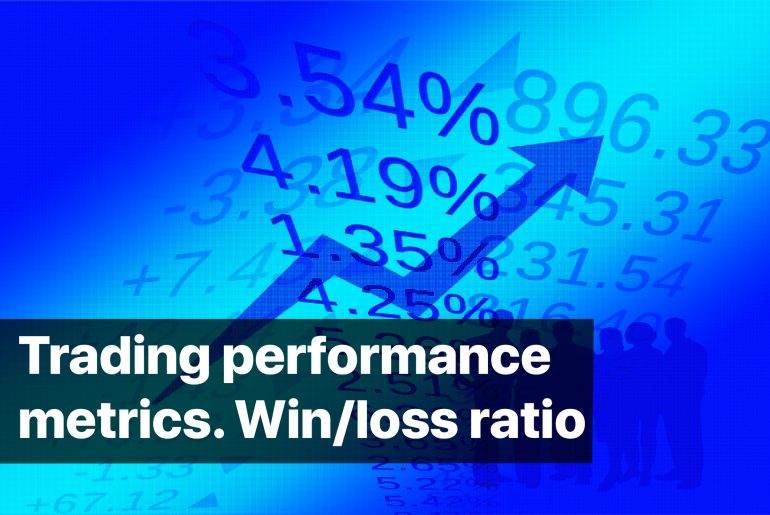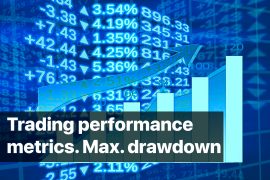We continue our series of articles about key trading performance metrics. In this article, we break down the win/loss ratio, but before we start, it’s worth mentioning why we pay so much attention to this issue.
Thus, key trading performance metrics are an integral part of the all-round assessment of trading results that serves as a base for trading system development. Why are they so essential? The idea is that history teaches us great things. The same is about your trading history. It reflects how your actions influence your trading results and provides you with meaningful insights into your strengths and weaknesses. Therefore, to get a comprehensive picture of the efficiency of your trading strategy, follow 2 simple steps:
- Precisely record your trading statistics (manually and/or automatically). This way, you can review your trading performance.
- Calculate the additional trading performance metrics. In this case, you are able to evaluate your trading results.
With such a powerful instrument as statistics, you are likely to get an edge in trading. We already discussed such important metrics as profit factor and maximum drawdown. Let’s continue our learning curve with a win/loss ratio that is also often calculated and tracked by professional traders.
Win/loss ratio is calculated as the total number of your winning trades divided by the total number of your losing trades over a particular period of time:
In other words, it tells how many times you had profitable trades relative to losing trades. For example, you had 100 trades a week. In 65 of them, you gained, while the rest 35 brought you losses. In this case, your win/loss ratio will be the following:
Thus, you won 1.86 times (almost 2!) more than lost. Obviously, if you win more often than lose, your win/loss ratio is more than 1. If the number of your wins is equal to losing trades, your win/loss ratio is 1. If you have more losing trades, your win/loss ratio is less than 1.
But wait. Does it mean that you are a profitable trader? Absolutely no. Win/loss ratio won’t tell if a trader is a loser or winner. It considers only a ratio of your winning and losing trades, but not the amounts of money won or lost (a ratio of numbers, not amounts). However, specifically these amounts finally make up your final balance.
So, what win/loss ratio is for? Simply, it serves as a basis for some meaningful calculations that directly influence the profitability of your trading strategy. Primarily, for risk/reward ratio. Let’s observe a basic example.
Win/loss ratio is used to determine optimal risk/reward ratio
Imagine you implemented your trading strategy for a week. You make 10 trades, 6 of which turned out to be profitable, while 4 were losing. So, your risk/reward is 6/4, or 3/2, or 1.5. You win 1.5 times more than lose. Sounds great, doesn’t it?
However, let’s dive deeper and consider 2 scenarios. In both scenarios win/loss ratio stays the same. The only difference is the amounts of your losses and profits in each trade. In other words, the ratio between your stop-loss and take-profit orders, also known as a risk-reward ratio. To clarify, this ratio determines when you close a trade if you lose or win. By the way, it is one of the key points to include into your trading plan and trading journal (it should be calculated in advance!).
The risk/reward ratio is the ratio between the capital you put at risk (ready to lose) in each trade to the profits you are aimed to get as a reward for your risk.
Scenario №1
According to the first scenario, you set a take profit at 100 points, and stop-loss at 90 points. Hence, your risk/reward ratio is 9/10. It means that you close your trade after the price has passed 100 points from the entry point if you gain in this trade. If you lose, you close your trade after the price has passed 90 points from your entry.
- 6 winning trades with 100 points reward for each
- 4 losing trades with 90 points loss for each
- Trading fees equal to 30 points for each of 10 trades you made
As a result, you get a loss of 60 points, even having 6 profitable trades out of 10! So, you can boast of your win/loss ratio, but in fact, you are a loser.
Scenario №2
On the flip side, according to the second scenario, you apply the same strategy (win/loss ratio stays 1.5), but set a different risk/reward ratio with take profit at 100 points, and stop-loss at 30 points. Thus, your risk/reward ratio is 3/10.
- 6 winning trades with 100 points reward for each
- 4 losing trades with 30 points loss for each
- Trading fees equal to 30 points for each of 10 trades you made
In this case, you get 180 points profit!
It brings us to the conclusion that no matter how many times you win in respect to how many times you lose. Nowever, obviously, if you knew your win/loss ratio, you would have chosen the right risk/reward and followed the second successful scenario, even having a win/loss rate below 1.
“Win or lose, everybody gets what they want out of the market. Some people seem to like to lose, so they win by losing money.” (с) Ed Seykota
Thus, win/loss ratio provides vital information to build an effective trading strategy. If you calculate your risk/reward ratio based on win/loss ratio you are more likely to manage and even predict your future returns. Therefore, win/loss ratio is a MUST to gather and calculate. Along with other trading performance indices, it will help you strike a balance in your trading strategy and reach long-term profitability. So, gather, analyze and improve! By the way, we considered this part of trading strategy development and included trading performance indicators in Bitinsure. Thus, you can search your trading statistics and key performance indicators through sophisticated charts, focus on what matters most (your strategy!) and avoid routine and mistakes:

However, it should be mentioned that although trading statistics and key performance metrics make up a solid basis for successful trading (read about this approach applied in hedge funds), they are only a part of a complex trading system. Therefore, to ensure long-term profitability, consider also precise planning of your trading, think of a trading journal, and pay special attention to risk management.
Stay tuned and join our social media:
Telegram: https://t.me/bitinsurecom
Facebook: https://www.facebook.com/bitinsure
Twitter: https://twitter.com/bitinsure_news



